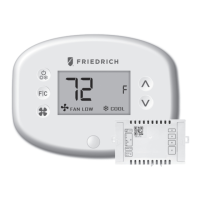95
APPENDIX 2 - Glossary
“Automatic Fan Control Mode” - fan runs only when
there is a demand for heating or cooling;
“Manual Fan Control Mode” - occupant can select
between automatic or continuous fan operation;
“Minimum Set point” - minimum temperature that
a occupant can request;
“Maximum Set point” - maximum temperature
that a occupant can request;
“Auto Changeover Set Point Offset” - the difference
between the occupant-selected set point and the
heat and cool changeover temperatures;
“1st Stage Differential - Heat” - the amount of
degrees the Wall Controller has to sense between
the automatic changeover temperature for heat
and the room temperature before a call for the 1st
stage heating is initiated;
“2nd Stage Differential - Heat” - difference
between 1st stage heating temperature and
room temperature before the 2nd stage heating
is initiated;
“1st Stage Differential - Cool” - the amount of
degrees the Wall Controller has to sense between
the automatic changeover temperature for cool
and the room temperature before a call for the 1st
stage cooling is initiated;
“Maximum Setback Temperature” - the highest
room temperature allowed when Wall Controller is
in the setback mode;
“Minimum Setback Temperature” - the lowest
room temperature allowed when Wall Controller is
in the setback mode;
“Temperature Setback Delay” - the length of
time for which the room that is in the occupant
occupancy mode needs to be unoccupied before
the temperature setback is initiated;
“Incidental Occupancy Threshold” - the minimum
period of time (in minutes) for which occupancy
needs to be detected in order to enter the
“Occupant Occupancy” mode;
“Night Occupancy Threshold” - the minimum
period of time during the “Night Occupancy”
period for which occupancy needs to be detected
in order to enter the “Night Occupancy” mode;
“Night Occupancy Period” - The period of
time during the day during which the “Night
Occupancy” mode can be activated if occupancy
longer than the “Night Occupancy Threshold” is
detected;
“Auto Restore On” - Wall Controller will restore
the most recent occupant settings when new
occupancy is detected;
“Auto Restore Off” - Wall Controller will NOT
restore the most recent occupant and will remain
turned off settings when new occupancy is
detected;
“Setback Set points On” - Wall Controller will
maintain setback temperatures when room is
unoccupied;
“Setback Set points Off” - Wall Controller will NOT
maintain setback temperatures when room is
unoccupied;
“Incidental Occupancy” - occupancy shorter than
the “Incidental Occupancy Threshold”;
“Occupant Occupancy” - occupancy longer than
the “Incidental Occupancy Threshold”;
“Temperature Setback” - Wall Controller maintains
setback temperatures and not the occupant set
point temperature in order to save energy;
“Night Occupancy Mode” - Wall Controller
status during which setback mode is disabled
if occupancy longer than “Night Occupancy
Threshold” is detected within the “Nigh
Occupancy” period;
“Automatic Temperature Changeover” - Wall
Controller automatically activates heating or
cooling to maintain the desired room temperature;

